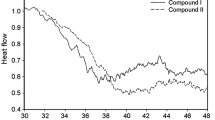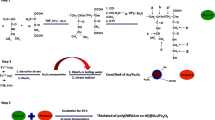Abstract
Stimulus-responsive nanoparticles have been widely used for many applications in biotechnology and medicine. In this study, dual thermo- and pH-responsive P(NIPAM-co-DMAEMA)-g-PEG nanoparticles has been synthesized by emulsion polymerization. The obtained nanoparticles were characterized by TEM, DLS, UV–Vis, 1HNMR and GPC analytical methods. The P(NIPAM-co-DMAEMA)-g-PEG nanoparticles showed higher LCST than poly(N-isopropylacrylamide) nanoparticles at 45 °C. Swelling and drug release measurements were taken under different conditions. The released amount of methotrexate (MTX) at normal physiological pH and temperature was limited (24%), while an accumulation drug release of about 70% was obtained after 48 h at pH = 5.5 under hyperthermia conditions (45 °C). MTX release data from the prepared nanoparticles were applied to the various conventional kinetic equations. The model with the highest R2 was considered as the best one. MCF-7 cell line was used to evaluate the cytotoxicity of the unloaded and MTX-loaded nanoparticles alone or in combination with hyperthermia. The results showed that the MTX-loaded nanoparticles in combination with hyperthermia suppressed tumor growth efficiently. According to the results, it can be concluded that the prepared nanoparticles might be regarded as promising agents in controlled drug delivery and multimodal cancer therapy to achieve a more effective treatment.








Similar content being viewed by others
References
Zugazagoitia J, Guedes C, Ponce S, Ferrer I, Molina-Pinelo S, Paz-Ares L (2016) Current challenges in cancer treatment. Clin Ther 38(7):1551–1566. https://doi.org/10.1016/j.clinthera.2016.03.026
Zhao C-Y, Cheng R, Yang Z, Tian Z-M (2018) Nanotechnology for cancer therapy based on chemotherapy. Molecules 23(4):826–855. https://doi.org/10.3390/molecules23040826
Oliva N, Conde J, Wang K, Artzi N (2017) Designing hydrogels for on-demand therapy. Acc Chem Res 50(4):669–679. https://doi.org/10.1021/acs.accounts.6b00536
Brigger I, Dubernet C, Couvreur P (2002) Nanoparticles in cancer therapy and diagnosis. Adv Drug Deliv Rev 54(5):631–651. https://doi.org/10.1016/S0169-409X(02)00044-3
Deshpande PP, Biswas S, Torchilin VP (2013) Current trends in the use of liposomes for tumor targeting. Nanomedicine 8(9):1509–1528. https://doi.org/10.2217/NNM.13.118
Chai Q, Jiao Y, Yu X (2017) Hydrogels for biomedical applications: their characteristics and the mechanisms behind them. Gels 3(1):6–21. https://doi.org/10.3390/gels3010006
Ferreira NN, Ferreira LMB, Cardoso VMO, Boni FI, Souza ALR, Gremião MPD (2018) Recent advances in smart hydrogels for biomedical applications: from self-assembly to functional approaches. Eur Polym J 99:117–133. https://doi.org/10.1016/j.eurpolymj.2017.12.004
Harrison IP, Spada F (2018) Hydrogels for atopic dermatitis and wound management: a superior drug delivery vehicle. Pharmaceutics 10(2):71–84. https://doi.org/10.3390/pharmaceutics10020071
Zhao C, Zhuang X, He P, Xiao C, He C, Sun J, Chen X, Jing X (2009) Synthesis of biodegradable thermo- and pH-responsive hydrogels for controlled drug release. Polymer 50(18):4308–4316. https://doi.org/10.1016/j.polymer.2009.07.010
Lin C-L, Chiu W-Y, Lee C-F (2005) Thermal/pH-sensitive core-shell copolymer latex and its potential for targeting drug carrier application. Polymer 46(23):10092–10101. https://doi.org/10.1016/j.polymer.2005.07.098
Peng C-L, Tsai H-M, Yang S-J, Luo T-Y, Lin C-F, Lin W-J, Shieh M-J (2011) Development of thermosensitive poly(n-isopropylacrylamide-co-((2-dimethylamino) ethyl methacrylate))-based nanoparticles for controlled drug release. Nanotechnology 22(26):265608–265619. https://doi.org/10.1088/0957-4484/22/26/265608
Huang Y, Yong P, Chen Y, Gao Y, Xu W, Lv Y, Yang L, Reis RL, Pirraco RP, Chen J (2017) Micellization and gelatinization in aqueous media of pH- and thermo-responsive amphiphilic ABC (PMMA82-b-PDMAEMA150-b-PNIPAM65) triblock copolymer synthesized by consecutive RAFT polymerization. RSC Adv 7(46):28711–28722. https://doi.org/10.1039/c7ra04351a
Jokerst JV, Lobovkina T, Zare RN, Gambhir SS (2011) Nanoparticle PEGylation for imaging and therapy. Nanomedicine 6(4):715–728. https://doi.org/10.2217/NNM.11.19
Guerrini L, Alvarez-Puebla R, Pazos-Perez N (2018) Surface modifications of nanoparticles for stability in biological fluids. Materials 11(7):1154–1182. https://doi.org/10.3390/ma11071154
Suk JS, Xu Q, Kim N, Hanes J, Ensign LM (2016) PEGylation as a strategy for improving nanoparticle-based drug and gene delivery. Adv Drug Deliv Rev 99:28–51. https://doi.org/10.1016/j.addr.2015.09.012
Zheng Y, Wang L, Lu L, Wang Q, Benicewicz BC (2017) pH and thermal dual-responsive nanoparticles for controlled drug delivery with high loading content. ACS Omega 2(7):3399–3405. https://doi.org/10.1021/acsomega.7b00367
Yadavalli T, Ramasamy S, Chandrasekaran G, Michael I, Therese HA, Chennakesavulu R (2015) Dual responsive PNIPAM–chitosan targeted magnetic nanopolymers for targeted drug delivery. J Magn Magn Mater 380:315–320. https://doi.org/10.1016/j.jmmm.2014.09.035
Wang J, Su S, Qiu J (2017) Biocompatible swelling graphene oxide reinforced double network hydrogels with high toughness and stiffness. New J Chem 41(10):3781–3789. https://doi.org/10.1039/c6nj03791g
Reis S, Gomes MJ, Martins S, Ferreira D, Segundo MA (2014) Lipid nanoparticles for topical and transdermal application for alopecia treatment: development, physicochemical characterization, and in vitro release and penetration studies. Int J Nanomed 9:1231–1242. https://doi.org/10.2147/ijn.s45561
Acknowledgements
The authors would like to thank the School of Pharmacy, Isfahan University of Medical Science, Isfahan, Iran, for financing this project.
Author information
Authors and Affiliations
Contributions
This article was extracted from the Ph.D. research project of Aylar Najafipour. She performed all the lab experiments by herself. Ali Reza Mahdavian, Hojjat Sadeghi Aliabadia and Afshin Fassihi were the supervisors of the chemistry part of this project.
Corresponding author
Ethics declarations
Conflict of interest
There are no conflicts of interest in this report.
Additional information
Publisher's Note
Springer Nature remains neutral with regard to jurisdictional claims in published maps and institutional affiliations.
Rights and permissions
About this article
Cite this article
Najafipour, A., Mahdavian, A.R., Aliabadi, H.S. et al. Dual thermo- and pH-responsive poly(N-isopropylacrylamide-co-(2-dimethylamino) ethyl methacrylate)-g-PEG nanoparticle system and its potential in controlled drug release. Polym. Bull. 77, 3129–3142 (2020). https://doi.org/10.1007/s00289-019-02895-9
Received:
Revised:
Accepted:
Published:
Issue Date:
DOI: https://doi.org/10.1007/s00289-019-02895-9




